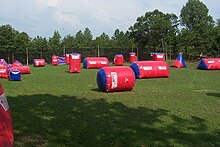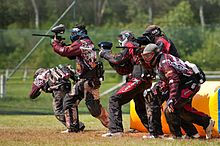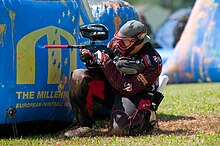
Shooting sports is a group of competitive and recreational sporting activities involving proficiency tests of accuracy, precision and speed in shooting — the art of using ranged weapons, mainly small arms and bows/crossbows.

Paintball is a competitive team shooting sport in which players eliminate opponents from play by hitting them with spherical dye-filled gelatin capsules called paintballs that break upon impact. Paintballs are usually shot using low-energy air weapons called paintball markers that are powered by compressed air or carbon dioxide and were originally designed for remotely marking trees and cattle.
Tippmann is an American manufacturer of paintball markers and paintball equipment, including military simulation (MilSim) kits. A related company, Tippmann Industrial Products manufactures manual and pneumatic heavy-duty sewing machines primarily used for leather, other leather-related equipment, and some industrial products. Originally a family-owned business run from Fort Wayne, Indiana, in 2004 Dennis Tippmann Sr. sold a majority ownership stake to Summit Partners, a private equity firm. Tippmann designed one of the first automatic markers, the use of refillable air systems in place of 12 gram cartridges, the "Cyclone Feed" system, the "Flatline" barrel, and the Tippmann C-3, the first propane-powered marker.

Scenario paintball is a colloquialism used to represent a diverse array of paintball events that encompass many themes that may include historical re-enactments, movies, current pop culture, futuristic or video game simulations, and more. Others have no theme at all. They frequently feature game mechanics such as "medics" and "snipers" and "helicopters" carried out through various simulations. The common denominator for this type of play is anywhere from 75 to 5000 players, with at least 6 hours of continuous play. These events average 12 hours of game play across a weekend in 2 major play periods. The longest and most challenging events run 24 hours straight with no breaks, with elite players covering ultra marathon distances. Instead of playing on a single field at a venue, all fields are combined into one continuous playable area. To further enhance the theme of a game, field locations may be named for important story locations, and props of various sorts are added to the game. These may be objects that players collect for points, or even vehicles that take part in the fighting, like paintball tanks. Players may don costumes specific to the theme, such as historic military uniforms or other costumes.
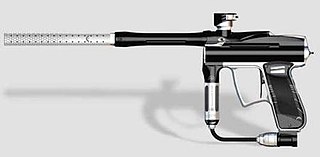
The Angel is one of the first electropneumatic paintball markers. It was manufactured by Angel Paintball Sports starting in 1997 and was introduced alongside Smart Parts' original Shocker.
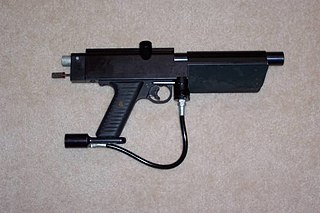
The Autococker is a closed-bolt semiautomatic paintball marker manufactured by Worr Game Products (WGP). It was one of the first paintball markers to be designed specifically for the sport, and has long been known throughout the paintball community for its popularity and customizability as well as its complexity. It is commonly believed that the closed-bolt design of the marker makes it inherently more accurate than its open-bolt counterparts, though this is disputed.
Smart Parts was a paintball manufacturing company in Latrobe, Pennsylvania, which filed for liquidation on July 28, 2010. As of August 22, 2010 Smart Parts' assets and intellectual property were acquired by Kee Action Sports.

A paintball marker, also known as a paintball gun, paint gun, or simply marker, is an air gun used in the shooting sport of paintball, and the main piece of paintball equipment. Paintball markers use compressed gas, such as carbon dioxide (CO2) or compressed air (HPA), to propel dye-filled gel capsules called paintballs through the barrel and quickly strike a target. The term "marker" is derived from its original use as a tool for forestry personnel to mark trees and ranchers to mark wandering cattle.
Paintball is an equipment-intensive sport and in order to safely conduct a game, every player requires a marker with propellant to fire the paint, a mask to protect the eyes and face, paintballs, and a loader to hold them. To ensure safety off the playing field, a barrel sock or plug for the marker is also compulsory.
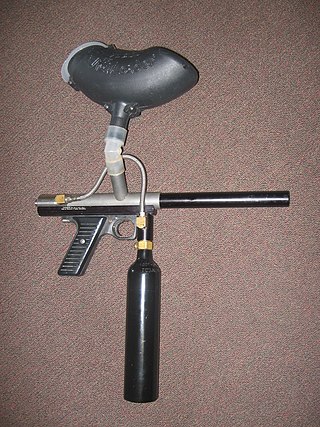
The Automag is a paintball marker designed by Tom Kaye and produced by Airgun Designs, Inc. It bears the distinction of being the first semi-automatic marker ever to win a paintball tournament. Team Swarm used Automags in their victory at the 1990 International Masters.
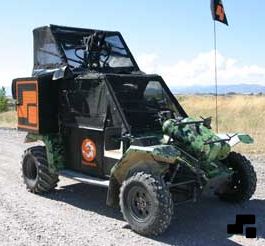
A paintball tank, also known as a paintball armoured vehicle, (pav), is a vehicle, or a portable structure that resembles a vehicle, sometimes used in the sport of paintball, usually with the intent of military simulation. The purpose of the tank is to provide a mobile shelter for one or several players, from which they may employ their markers against players on the opposing team. Small pneumatic guns, effectively low-powered potato cannons loaded with foam darts, are also often employed against other tanks.
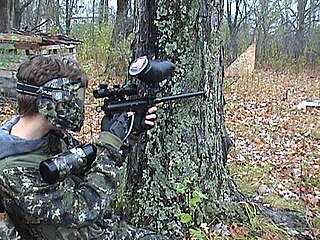
Woodsball is a format of paintball gaming, in which players compete in a natural outdoors area or a recreation of a town called urban fields using paintball guns to mark opponents. The term woodsball is sometimes used to describe non-milsim airsoft games, which take place in a forest.
Paintball is played with a potentially limitless variety of rules and variations, all of which are specified before the game begins. The most basic of all game rules is that players must attempt to accomplish a goal without being tagged with paintballs. Generally paintball is divided into either its original incarnation woodsball, or the small arena-based and tournament de facto speedball. Amongst these paintball game types, variations of basic rules can be played.
Oliver "Ollie" Lang is an American professional paintball player, who by the age of 22 in 2005, had already been awarded the International Paintball Player of the Year award. Paintballer Matt Marshall has stated that Lang “wins so frequently, plays our sport so instinctually, and gobbles up life on the road at such a frantic and furious pace.”
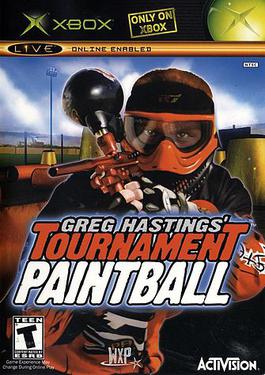
Greg Hastings' Tournament Paintball is a 2004 first-person paintball game released exclusively for the Xbox. The game gathered a cult following, consistently appearing on the Xbox Live Top 25 list posted by Major Nelson, peaking at the number nine position. A spin-off, Greg Hastings Tournament Paintball MAX'D, was also released on multiple platforms many months later, with a full sequel released in 2010 for the Wii, PlayStation 3 and Xbox 360.
The CCI Phantom is a Nelson-based pump action paintball marker developed and produced by Mike Casady. Production began in 1987 after about six months of prototype work. The name for the marker was derived from the much more stealth-oriented and drawn-out style of play that was typical when the game was first developing. The Phantom was designed to be powered by a single 12-gram CO2 Powerlet, but larger tanks may also be used by removing the powerlet adapter or using a dummy powerlet. When first introduced the marker featured a fixed barrel assembly referred to as a "unibody" combined with a modified Crosman air pistol frame and brass bead sight. However, since roughly 1989 the body and barrel of the marker have been two distinct parts and no longer feature the bead style sight. The marker is also capable of supporting bulk gravity fed hoppers by using a different breach type. The Phantom is one of only a handful of readily available markers acceptable for use in the various forms of stock class paintball. However, because the Phantom is capable of auto-triggering and features barrel porting it is considered to be a modified stock class marker.

Paintball pistols are a type of paintball marker used in paintball, which loosely resemble pistols. There are two main types of pistols: pump and semi-automatic.
WDP PAINTBALL LTD owns and operates NPF Bassetts Pole Adventure Park, a paintball site / adventure park in Birmingham., England. The company WDP is also known for manufacturing the Angel line of electropneumatic paintball markers.

NPPL: Championship Paintball 2009 is a first-person paintball simulation game developed by Sand Grain Studios and released in 2008 for Xbox 360, PlayStation 2, PlayStation 3 and Wii.

An electropneumatic paintball marker is a paintball marker that uses a pneumatic solenoid to actuate the hammer and/or bolt's movement.

